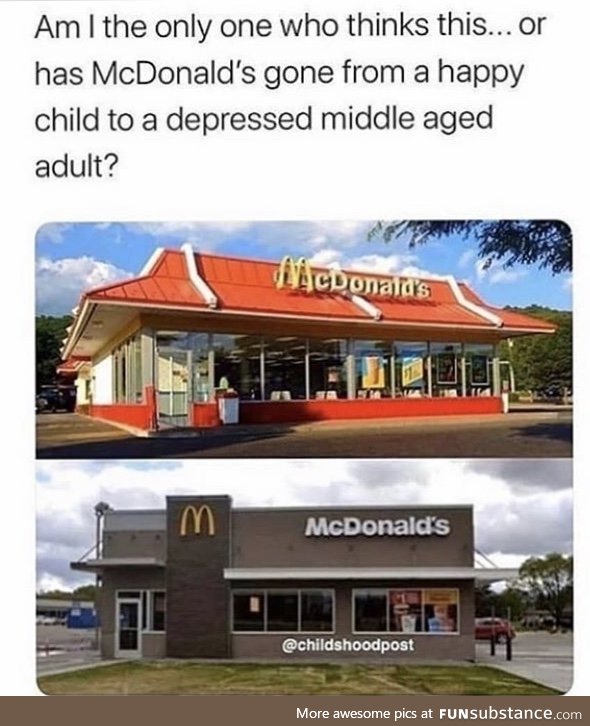Instead of a happy meal, you’ll get a depressed meal
5 years ago by dash224 · 389 Likes · 11 comments · Fresh
Report
Comments
Follow Comments Sorted by time
iccarus
· 5 years ago
· FIRST
everything goes from unique and individualised, to modern and aesthetic
6
demon_razgriz
· 5 years ago
Grown up with its Market maybe?
1
guest_
· 5 years ago
Sort of. McDonalds very specifically marketed towards children. Not all that long ago in the USA fast food wasn’t as common a meal, and was often associated with- well, children or immature qualities. McDonald’s started getting made fun of in ads by competitors who would appeal to an increasing market of adults buying fast food for themselves and not because they had kids as a “treat” or on a road trip or when busy.
guest_
· 5 years ago
This was a movement through the industry- “Jack” of Jack in the box fame had been their mascot- every drive through had a Jack in the Box head as an order box! But... for the time period this was seen as “childish” and fast food in the US was trying to show it was “grown up food” and attract grown up clients buying for themselves.
Show All
guest_
· 5 years ago
Around that same time, McDonald’s began to decide to distance itself from its childish image and its mascots. We saw it step further and further away from Its cast of characters like “Birdie” “Grimace” “The McNuggets” and such, the “McDonald’s play place” being downplayed or removed all together; and only their Mascot- Ronald McDonald remained.
guest_
· 5 years ago
They moved Ronald to the background- but for the last 20 odd years clowns haven’t been as popular as they once were. One of the final nails in the coffin for Ronald was that whole “killer clown” scare some years back. McDonald’s pulled him all together during that period and retired him shortly after.
guest_
· 5 years ago
Another major factor in McDonald’s rebranding has been increased public awareness and interest in health and the environment, as well as pressure and legal liability. In the 90’s McDonald’s got a lot of media heat for its packaging, so first they got rid of styrofoam packaging, and then later severely curtailed their mass use of “promo packaging” that went to waste when promo periods ended. Their “aduktification” is in line with that-
guest_
· 5 years ago
Changes to their menu to include “healthier” options or at least options which SEEM healthier- dropping the term “super size” and the option all together (the documentary “Supersize Me” and backlash as well as health concerns and legal concerns largely prompted this). But not only does their newer color scheme and decor speak to a more “grown up contemporary” look- but it also is designed to emulate cues people associate with brands and the idea of things like health, quality, and quaintness.
guest_
· 5 years ago
The modern consumer is aware of- and largely hostile to the aesthetic of the tacky mega brand. People gravitate towards “locally sourced” or “local business” “sustainable” “organic” etc. McDonald’s has worked to push each location as “owner operated” by local businesses as a franchise as opposed to a faceless multinational. They changed the oil used for their fries, push hard on their “100% beef patties” and changed packaging, branding, and location to try to emulate a more “rustic” or “organic” look often seen at smaller “green” businesses.
guest_
· 5 years ago
We’ve seen this trend with chains like “Five Guys” listing the local supplier of the peanuts used in their fry oil on signs in the dining area, other chains showing the “local farm” or “family farm” that supplies some or all their meat etc. chipotle perhaps exemplifies the idea of a chain fast food place using various tricks and design choices to create an atmosphere more akin to a local small business focused on health or environment.
guest_
· 5 years ago
So to sum up an Tl:dr- McDonald’s used to be focused on marketing to children to get parents wallets. Like many chains at the time, they started to move away from their “child focused” image to appeal to adults directly as a place THEY could eat. As the public started to rally against how unhealthy fast food was, and against marketing unhealthy things to children, McDonald’s took further steps to not pull a “Joe Camel” and end up in legal or PR hot water over targeting children with inherently unhealthy meals using cartoons and toys. They then further “sanitized” their brand to try to mitigate the shift of consumers to wanting quality, responsibly sourced, healthy meals. The end result is a transformation from a play ground selling cheap unhealthy food in huge portions to a wanna be Whole Foods look alike selling unhealthy food with buzzwords in slightly smaller portions at higher prices.












